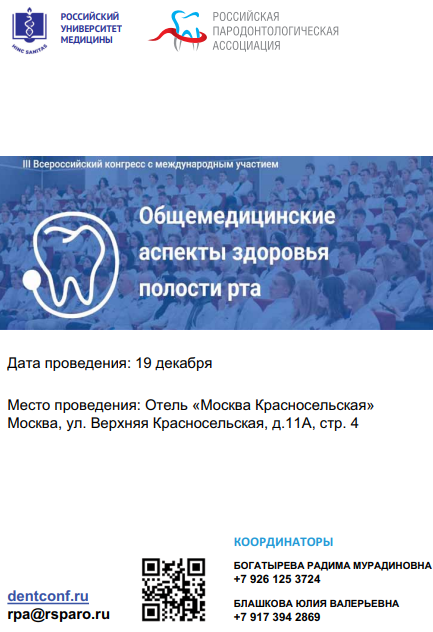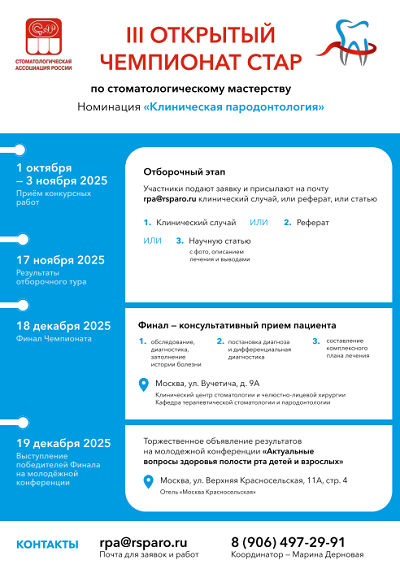Пародонтопатогены: новый взгляд. Систематический обзор. Часть 1
https://doi.org/10.33925/1683-3031-2020-20-1-70-76
Аннотация
Актуальность. Современный взгляд на пародонтит как на дисбиотическое заболевание, возникающее в результате изменения микробного состава поддесневой области, рассмотрено в систематическом обзоре.
Цель. Изучить новую парадигму развития генерализованного пародонтита. Материалы и методы. Для изучения отбирались рандомизированные контролируемые исследования (РКИ), в том числе кластерные РКИ, контролируемые (нерандомизированные) микробиологические и клинические исследования микробиома полости рта у взрослых пациентов с генерализованным пародонтитом за последние 10 лет.
Результаты. Развитие дисбиоза пародонта происходит в течение некоторого периода времени, который медленно превращает симбиотическую ассоциацию хозяина и микроба в патогенную. В этом обзоре рассматривается современная парадигма прогрессирования пародонтита, которая ставит под сомнение традиционную концепцию заболевания, индуцируемого несколькими частными пародонтопатогенными микроорганизмами, принадлежащими к красному комплексу.
Выводы. Как следует из современной литературы, пародонтит в определенной степени вызван переходом от гармоничного симбиотического бактериального сообщества к дисбиотическому. Последние научные исследования показали, что один микроорганизм не способен вызывать заболевание, что к развитию патологии приводит деятельность микробного сообщества в целом.
Об авторах
Е. С. СлажневаРоссия
Слажнева Екатерина Сергеевна, очный аспирант кафедры пародонтологии
Москва
Е. А. Тихомирова
Россия
Тихомирова Екатерина Александровна, очный аспирант кафедры пародонтологии
Москва
В. Г. Атрушкевич
Россия
Атрушкевич Виктория Геннадьевна, д.м.н., профессор кафедры пародонтологии, вице-президент Российской пародонтологической ассоциации
Москва
Список литературы
1. F. A. Roberts, R. P. Darveau. Microbial protection and virulence in periodontal tissue as a function of polymicrobial communities: symbiosis and dysbiosis. Periodontol 2000. 2015;Oct;69(1):1827. https://doi.org/10.1111/prd.12087.
2. A. P. V. Colombo, A. C. R. Tanner. The Role of Bacterial Biofilms in Dental Caries and Periodontal and Peri-implant Diseases: A Historical Perspective. J Dent Res.2019;Apr;98(4):373-385. https://doi.org/10.1177/0022034519830686.
3. R. J. Lamont, H. Koo, G. Hajishengallis. The oral microbiota: dynamic communities and host interactions. Nat Rev Microbiol. 2018;Dec;16(12):745-759. https://doi. org/10.1038/s41579-018-0089-x.
4. A. S. Schaefer, G. M. Richter, M. Nothnagel et al. A 3' UTR transition within DEFB1 is associated with chronic and aggressive periodontitis. Genes and Immunity. 2010;11:45-54. https://doi. org/10.1038/gene.2009.75.
5. A. Mira, A.Simon-Soro, M. A. Curtis. Role of microbial communities in the pathogenesis of periodontal diseases and caries. J Clin Peri
6. odontol. 2017.Mar;44;Suppl18:S23-S38. https:// doi.org/10.1111/jcpe.12671.
7. A. B. Rajendra Santosh, O. E. Ogle, D. Williams, E. F. Woodbine. Epidemiology of Oral and Maxillofacial Infections. Dent Clin North Am. 2017;Apr;61(2):217-233. https://doi. org/10.1016/j.cden.2016.11.003.
8. S. A. Mosaddad, E. Tahmasebi. Oral microbial biofilms: an update. Eur J Clin Microbiol Infect Dis. 2019;Nov;38(11):2005-2019. https:// doi.org/10.1007/s10096-019-03641-9.
9. C. H. Stanley, L. Jeffrey. Porphyromonas gingivalis, Treponema denticola, and Tannerella forsythia: the «red complex», a prototype polybacterial pathogenic consortium in periodontitis. Periodontology 2000. 2005;38:72-122. https:// doi.org/10.1111/j.1600-0757.2005.00113.x.
10. K. Y. How, K. P. Song. Porphyromonas gingivalis: An Overview of Periodontopathic Pathogen below the Gum Line. Front Microbiol. 2016;Feb;9;7:53. https://doi.org/10.3389/fmicb.2016.00053.
11. B. Retamal-Valdes, M. C. Formiga. Does subgingival bacterial colonization differ between implants and teeth? A systematic review. Braz Oral Res. 2019;30;33(suppl1):e064. https://doi. org/10.1590/1807-3107bor-2019.vol33.0064.
12. N. Silva, L. Abusleme. Host response mechanisms in periodontal diseases J Appl Oral Sci. 2015;23(3):329-355. https://doi. org/10.1590/1678-775720140259.
13. W. Zhu, S.W. Lee. Surface interactions between two of the main periodontal pathogens: Porphyromonas gingivalis and Tannerella forsythia. J Periodontal Implant Sci. 2016;Feb;46(1):2-9. https://doi.org/10.5051/jpis.2016.46.1.2.
14. G. Dahlen, A. Basic. Importance of Virulence Factors for the Persistence of Oral Bacteria in the Inflamed Gingival Crevice and in the Pathogenesis of Periodontal Disease. J Clin Med. 2019;Aug;29;8(9). https://doi.org/10.3390/jcm8091339.
15. S. C. Holt, J. L. Ebersole. Porphyromonas gingivalis, Treponema denticola, and Tannerella forsythia: the “red complex“, a prototype polybacterial pathogenic consortium in periodontitis. Periodontology 2000. 2005;38:72-122. https:// doi.org/10.1111/j.1600-0757.2005.00113.x.
16. X. Xu, Z. Wang, X. Zhang. The human microbiota associated with overall health. Crit Rev Biotechnol. 2015;Mar;35(1):129-140. https://doi. org/10.3109/07388551.2013.819485.
17. E. M. Nowicki. Microbiota and Metatranscriptome Changes Accompanying the Onset of Gingivitis. mBio. 2018;Mar-Apr:9(2). https://doi. org/10.1128/mBio.00575-18.
18. H. M. Ng, L. X. Kin . Bacterial interactions in pathogenic subgingival plaque. Microbial Pathogenesis. 2016;May;94:60-69. https://doi. org/10.1016/j.micpath.2015.10.022.
19. H. C. Flemming, J. Wingender. Biofilms: an emergent form of bacterial life. Nat Rev Microbiol. 2016;Aug;11;14(9):563-575. https://doi. org/10.1038/nrmicro.2016.94.
20. W. H. Bowen, R. A. Burne. Oral Biofilms: Pathogens, Matrix and Polymicrobial Interactions in Microenvironments. Trends Microbiol. 2018;Mar;26(3):229242. https://doi.org/10.1111/prd.12087.
21. M. Costalonga, M. C. Herzberg. The oral microbiome and the immunobiology of periodontal disease and caries. Immunology Letters. 2014;162(2PtA):22-38. https://doi. org/10.1016/j.imlet.2014.08.017.
22. В. М. Eley, S. W. Cox. Proteolytic and hydrolytic enzymes from putative periodontal pathogens: characterization, molecular genetics, effects on host defenses and tissues and detection in gingival crevice fluid Periodontology 2000. 2003;31:105-124. https://doi. org/10.1034/j.1600-0757.2003.03107.x.
23. J. L. Ebersole, D. 3rd Dawson. The periodontal war: microbes and immunity Periodontology 2000. 2017;75:52-115. https://doi. org/10.1111/prd.12222.
24. S. Tsuchida, M. Satoh. Ubiquitination in Periodontal Disease: A Review. Int J Mol Sci. 2017;Jul;18(7):1476. https://doi.org/10.3390/ ijms18071476.
25. A. M. Frey, M. J. Satur. Characterization of Porphyromonas gingivalis sialidase and disruption of its role in host-pathogen interactions. Microbiology. 2019;Nov;165(11):1181-1197. https://doi.org/10.1099/mic.0.000851.
26. A. Sharma. Virulence mechanisms of Tannerella forsythia Periodontology 2000. 2010;54:106-116. https://doi.org/10.1111/j.16000757.2009.00332.x.
27. P. D. Marsh, E. Zaura. Dental biofilm: ecological interactions in health and disease. J Clin Periodontol. 2017;Mar;44;Suppl18:S12S22. https://doi.org/10.1111/jcpe.12679.
28. H. S. Ong, O. Oettinger-Barak. Effect of azithromycin on a red complex polymicrobial biofilm.J Oral Microbiol. 2017;9(1):1339579. https://doi.org/10.1080/20002297.2017.1339579.
29. Y. Li, H. Guo. Coinfection with Fusobacterium nucleatum can enhance the attachment and invasion of Porphyromonas gingivalis or Aggregatibacter actinomycetemcomitans to human gingival epithelial cells. Arch Oral Biol. 2015;Sep;60(9):1387-1393. https://doi. org/10.1016/j.archoralbio.2015.06.017.
30. B. T. Rosier, P. D. Marsh, A. Mira. Resilience of the Oral Microbiota in Health: Mechanisms That Prevent Dysbiosis. J Dent Res. 2018;Apr;97(4):371-380. https://doi. org/10.1177/0022034517742139.
31. M. Zarco, T. Vess, G. Ginsburg. The oral microbiome in health and disease and the potential impactonpersonalized dental medicine. Oral Dis. 2012;18(2):109-120. https://doi. org/10.1111/j.1601-0825.2011.01851.x.
32. C. D. Long, G. C. Armitage. Bacterial diversity in the oral cavity of 10 healthy individuals. ISME J. 2010;4(8):962. https://doi.org/10.1038/ ismej.2010.30.
33. M. Wiernicka-Menkiszak, E. Dembowska. Localized. Aggressive Periodontitis – Diagnostics, Epidemiology, Etiopathogenesis. Dent Med Probl 2012;49(4):567-575. https://journals.indexcopernicus.com/search/ article?articleId=542288.
34. V. Meuric, S. Le Gall-David. Signature of Microbial Dysbiosis in Periodontitis. Appl Environ Microbiol. 2017;30;83(14). https://doi. org/10.1128/AEM.00462-17.
35. C. Y. Tang, T. Tan, K. Chen et al.Subgingival microbiota in individuals with severe chronic periodontitis. Journal of microbiology, immunology, and infection. 2018;Apr;51(2):226-234. https://doi.org/10.1016/j.jmii.2016.04.007.
36. P. Wang, D. Duan, X. Zhou et al. Relationship between expression of human gingival betadefensins and levels of periodontopathogens in subgingival plaque. J Periodont Res. 2015;50:113122. https://doi.org/10.1111/jre.12187.
37. V. T. Dosseva-Panova, C. L. Popova, V. E. Panov. Subgingival microbial profile and production of proinflammatory cytokines in chronic periodontitis. Folia medica. 2014;56(3):152-160. https://doi.org/10.2478/folmed-2014-0022. 37. X. Yong, Y. Chen, R. Tao et al. Periodontopathogens and human b-defensin-2 expression in gingival crevicular fluid from patients with periodontal disease in Guangxi, China. J Periodont Res. 2015;Jun;50(3):403-410. https://doi. org/10.1111/jre.12220.
38. M. Asad, A. W. Abdul Aziz, R. P. Raman et al. Comparison of nonsurgical periodontal therapy with oral hygiene instruction population alone for chronic periodontitis. J Oral Sci. 2017;59(1):111120. https://doi.org/10.2334/josnusd.16-0298.
39. K. Torrungruang, S. Jitpakdeebordin, O. Charatkulangkun et al. Porphyromonas gingivalis, Aggregatibacter actinomycetemcomitans, and Treponema denticola/ Prevotella intermedia coinfection are associated with severe periodontitis in a thai. PLoS One. 2015;Aug;27;10(8):e0136646. https://doi.org/10.1371/journal.pone.0136646.
40. U. Shet, H. K. Oh, H. J. Chung et al. Humoral immune responses to periodontal pathogens in the elderly. J Periodontal Implant Sci. 2015;Oct;45(5):178-183. https://doi.org/10.5051/ jpis.2015.45.5.178.
41. M. M. Usin, S. M. Tabares, J. Menso et al. Generalized aggressive periodontitis: microbiological composition and clinical parameters in non-surgical therapy.Acta Odontol. Latinoam. 2016;Dec;29(3):255-226. http://www.scielo.org. ar/pdf/aol/v29n3/v29n3a09.pdf.
42. J. R. Collins, S. Chinea, R. J. Cuello et al. Subgingival microbiological profile of periodontitis patients in Dominican Republic. Acta Odontol Latinoam. 2019;Apr;1;32(1):36-43. http://www. scielo.org.ar/pdf/aol/v32n1/v32n1a06.pdf.
Рецензия
Для цитирования:
Слажнева Е.С., Тихомирова Е.А., Атрушкевич В.Г. Пародонтопатогены: новый взгляд. Систематический обзор. Часть 1. Стоматология детского возраста и профилактика. 2020;20(1):70-76. https://doi.org/10.33925/1683-3031-2020-20-1-70-76
For citation:
Slazhneva E.S., Tikhomirova E.A., Atrushkevich V.G. Periodontopathogens: a new view. Systematic review. Part 1. Pediatric dentistry and dental prophylaxis. 2020;20(1):70-76. (In Russ.) https://doi.org/10.33925/1683-3031-2020-20-1-70-76





































